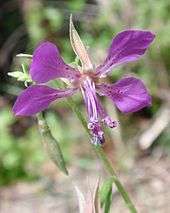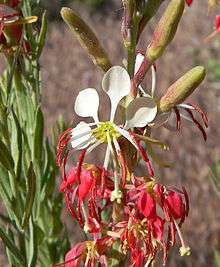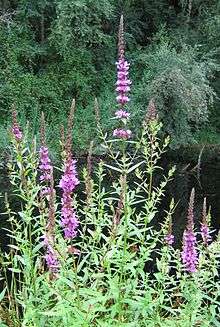List of Myrtales of Montana
There are at least 56 members of the evening-primrose and loosestrife order, Myrtales, found in Montana.[1] Some of these species are exotics (not native to Montana)[2] and some species have been designated as Species of Concern.[3]

Diamond clarkia, Clarkia rhomboidea
Evening-primrose

Scarlet gaura, Gaura coccinea
Family: Onagraceae
- Calylophus serrulatus, yellow evening primrose
- Camissonia andina, obscure evening-primrose
- Camissonia breviflora, short-flower evening-primrose
- Camissonia minor, small-flowered evening-primrose
- Camissonia parvula, small camissonia
- Camissonia scapoidea, naked-stemmed evening-primrose
- Camissonia subacaulis, long-leaf evening-primrose
- Camissonia tanacetifolia, tansy-leaf evening-primrose
- Circaea alpina, small enchanter's-nightshade
- Circaea alpina subsp. alpina, small enchanter's-nightshade
- Circaea alpina subsp. pacifica, small enchanter's-nightshade
- Clarkia pulchella, large-flower clarkia
- Clarkia rhomboidea, diamond clarkia
- Epilobium anagallidifolium, alpine willowherb
- Epilobium angustifolium, fireweed
- Epilobium brachycarpum, panicled willowherb
- Epilobium ciliatum, hairy willowherb
- Epilobium ciliatum subsp. ciliatum, fringed willowherb
- Epilobium ciliatum subsp. glandulosum, fringed willowherb
- Epilobium clavatum, clavate-fruit willowherb
- Epilobium densiflorum, dense spike-primrose
- Epilobium foliosum, california willowherb
- Epilobium glaberrimum, glaucous willowherb
- Epilobium halleanum, glandular willowherb
- Epilobium hornemannii, hornemann's willowherb
- Epilobium lactiflorum, white-flower willowherb
- Epilobium latifolium, dwarf fireweed
- Epilobium leptocarpum, slender-fruited willowherb
- Epilobium minutum, small-flower willowherb
- Epilobium oregonense, oregon willow-herb
- Epilobium palustre, marsh willowherb
- Epilobium palustre var. gracile, linear-leaved willowherb
- Epilobium palustre var. palustre, marsh willowherb
- Epilobium pygmaeum, smooth spike-primrose
- Epilobium saximontanum, rocky mountain willowherb
- Epilobium suffruticosum, shrubby willowherb
- Gaura coccinea, scarlet gaura
- Gaura parviflora, velvet-leaved gaura
- Gayophytum decipiens, deceptive groundsmoke
- Gayophytum diffusum, diffuse groundsmoke
- Gayophytum humile, low groundsmoke
- Gayophytum racemosum, racemed groundsmoke
- Gayophytum ramosissimum, much-branch groundsmoke
- Oenothera albicaulis, prairie evening-primrose
- Oenothera caespitosa, tufted evening-primrose
- Oenothera elata, hooker's evening-primrose
- Oenothera flava, long-tubed evening-primrose
- Oenothera nuttallii, white-stemmed evening-primrose
- Oenothera pallida subsp. pallida, pale evening-primrose
- Oenothera perennis, small sundrops
- Oenothera villosa, hairy evening-primrose
Loosestrife

Purple loosestrife, Lythrum salicaria
Family: Lythraceae
- Ammannia robusta, scarlet ammannia
- Lythrum alatum, winged-loosestrife
- Lythrum salicaria, purple loosestrife
- Rotala ramosior, toothcup
Further reading
- Schiemann, Donald Anthony (2005). Wildflowers of Montana. Missoula, MT: Mountain Press Publishing. ISBN 0-87842-504-7.
gollark: Just make the phone a bit thicker, I guess?
gollark: In any case, I have so far dropped my phone on solid surfaces... upward of 10 times, I think, and water zero.
gollark: I TOLD YOU THIS TWICE
gollark: THERE ARE PHONES WITH BOTH
gollark: WATERPROOFING AND REMOVABLE BATTERIES CAN COEXIST YOU TRIANGLE
See also
Notes
- "Evening-primrose and Loosestrife". Montana Natural Heritage Project. Retrieved 2011-06-17.
- Exotic species have been deliberately or accidentally introduced to areas outside of their native geographic range and are able to reproduce and maintain sustainable populations in these areas. These exotic populations may also be referred to as alien, introduced, invasive, non-native, or non-indigenous. "Species Status Codes, Exotics". Montana Natural Heritage Project. Retrieved 2011-06-17.
- Species of Concern are native taxa that are at-risk due to declining population trends, threats to their habitats, restricted distribution, and/or other factors. Designation as a Montana Species of Concern or Species of Concern is based on the Montana Status Rank, and is not a statutory or regulatory classification. Rather, these designations provide information that helps resource managers make proactive decisions regarding species conservation and data collection priorities. "Species Status Codes, Species of Concern". Montana Natural Heritage Project. Retrieved 2011-06-17.
This article is issued from Wikipedia. The text is licensed under Creative Commons - Attribution - Sharealike. Additional terms may apply for the media files.
